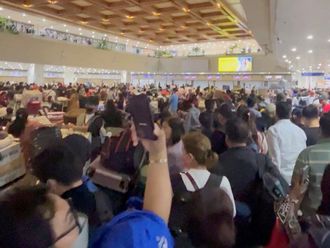
Highlights
- As older phones could stop working, regulators and service providers urge users to update their handsets.
- Telcos are shutting down ageing systems to pave for the newer, faster gear like 4G/5G.
- Massive increase in data consumption prompting carriers to embrace the faster and cost-effective mobile phone networks.
Dubai: Still using an old mobile phone? Good for you, but don't expect it to work forever. This year, many mobile carriers around the world are shutting down their 2G and 3G networks.
The reason: obsolescence. The ageing electronics underneath the old stacks need costlier maintenance. And the world is increasingly embracing newer, faster and more cost effective slutions, like as 4G and 5G.
As mobile phone subscriptions hit 8.6 billion (in 2021), telcos face greater capacity demands, especially for high-speed data. That's why many are now moving away from 2G/3G. The move is gradual. But some countries are moving sooner than others. As carriers shut down their legacy equipment, older devices like phones, alarm systems, and wearables (and even older Teslas) need to be upgraded, or they will lose data functionality.
Here’s what we know so far:
Will older phones stop working?
Yes. Many older phones, early iPads, older Kindles, wearables, alarm systems and classic Chromebooks — any device configured to work only on 2G/3G — simply won’t be able to connect to cellular data networks anymore.
Old flip phones and models not configured to work with Long-term Evolution or fourth generation (LTE/4G) /4G and 5G networks would be affected by the planned network retirements around the world.
Will Wi-Fi for older devices still work?
Yes (unless the device’s Wi-Fi radio itself is broken). But their mobile data connectivity could go blank.

Why are telcos switching off, or retiring 2G/3G?
There are a number of reasons: obsolescence, cost-savings, efficiency.
Obsolescence: these old network protocols are at least 20 years old. The electronics that run it need more maintenance or replacement with faster, better gear.
- Obsolescence: these old network protocols are at least 20 years old. The electronics that run it need more maintenance or replacement with faster, better gear.
- Cost savings: Logistically, LTE and 5G networks are more cost effective to operate — they can accommodate more users on one standard and there are essentially fewer maintenance issues.
- Efficiency: Telecom carriers are making room for 4G/5G networks (and, eventually, 6G).
Similar transitions took place in the past, like what happened to rotary phones. Some mobile carriers shut down their ageing networks when they upgraded their networks to support newer services.

For example, the Telecommunications and Digital Government Regulatory Authority (TDRA) told users that the UAE would stop selling all phones that work only on 2G network from June 2022.
Phone companies have the flexibility to choose the types of technologies and services they deploy — including when they retire older services to pave the way for faster, more efficient services to meet regulatory and consumer demands.
Will 2G/3G be shut down all at once?
No. Support for these older networks will be phased out by different carriers at different times, starting this 2022. But it’s clear they cannot go on forever.

What is the shutdown schedule?
Different carriers in different parts of the world have announced a rolling shutdown schedule:
US:
Given the retirement of older networks, US customers are urged to plan ahead to avoid losing connectivity — including the ability to call the emergency hotline 911.
Plans and timing to phase out US 3G services will vary by company and may change, but it will be this year. For example, this February (2022), AT&T announced it will finish shutting down its 3G. Verizon announced that will finish shutting down its 3G network by December 31, 2022.
T-Mobile announced that it will finish shutting down Sprint's 3G CDMA network by March 31, 2022 and Sprint’s 4G LTE network by June 30, 2022. It also announced it will shut down T-Mobile's 3G UMTS network by July 1, 2022, but has not yet announced a shutdown date for its 2G network.
Many other US carriers — such as Cricket, Boost, Straight Talk, and several Lifeline mobile service providers — utilise AT&T's, Verizon's, and T-Mobile's networks.

“If your mobile phone is more than a few years old, you may need to upgrade your device before your mobile provider shuts down its 3G network, to avoid losing service,” FCC stated in its latest advisory.
India:
India, the second-largest national telecom network, is home to more than 1 billion customers. It has seen 4G subscriber base growing steadily. That has prompted some telecom operators to start shutting down their 3G networks. Last year, Airtel and Vodafone-Idea (Vi) announced plans to phase out 3G to focus on 4G services. Mobile phone companies, too, have stopped selling 3G phones in the country.

Airtel first stopped 3G services in Kolkata last year as part of its efforts to scrap the service in the rest of the country. Since then, the telecom operator has been working to move its subscribers to the high-speed 4G network.
This 2022, Vodafone-Idea, India’s third-largest telecom service provider, will end its 3G services in Delhi, Bengaluru, Mumbai, and several other cities before phasing out from the rest of the country. The operator will continue to offer 2G services, while its network is also 5G-ready.
By the end of 2022, the 4G coverage in priority circles [areas] is expected to increase to more than 90 per cent, from about 83 per cent in March 2020, Business Line quoted Vodafone-Idea Chief Financial Officer Akshaya Moondra as saying.

Despite Airtel and Vodafone-India’s increasing focus on 4G, the state-run Bharat Sanchar Nigam Limited (BSNL) continues to provide 3G services throughout India. Reliance Jio, a late entrant into India’s huge telecom service markets, has only a 4G network across India.
The country is due to auction the 5G spectrum soon, but millions continue to use 2G (voice calls and SMS only). That’s why Airtel and Vodafone-Idea say they intend to continue offering 2G services. India is where 5G will co-exist with 2G in the foreseable
Philippines:
Since 2020, Globe Telecom has stopped issuing 3G SIMs. The carrier has urged customers to shift to LTE/4G. Globe said it seeks to accelerate the migration of subscribers to LTE/4G, and eventually to 5G.
To address the spike in demand for data, leading carriers like PLDT and Smart are gearing up for the shutdown of its 2G and 3G technologies to migrate to faster speed LTE and 5G technologies. Globe was the first mobile operator in Southeast Asia to commercially launch 5G AirFiber for Home use in 2019. The telco launched its 5G for mobile a year later. Smart, for its part, launched its 5G service commercially in July 2020 and was the first to roll-out 5G nationwide.
China:
There major domestic operators have announced a rolling shutdown of their 3G networks. In 2019, China Mobile announced it is shutting down its 3G network in certain regions in China. China Mobile was expected to completely switch off its network 2020. In 2020, China Telecom Yunnan Branch said it will gradually shut down its 3G-EVDO data services to speed up the deployment of 5G networks.

UK:
On January 25, 2022, Vodafone has announced is set to turn off the almost two-decade-old 3G network as usage dwindles. The company, which has about 18 million UK mobile customers, will now focus on using the freed-up spectrum to expand its 4G and 5G networks. Similar transitions took place
How do I know if my device is 2G/3G?
Some carrier websites provide lists of devices that will no longer be supported after 3G networks are shut down. There are ways to know whether your phone, or other connected device, may be affected:
- (a) Check the box/instruction manual (if still available). You know your device more than anyone and how long you’ve used it for.
- (b) You may check the online literature on the device, based on brand and model, to know its connectivity protocol.
- (c) You may also contact your mobile provider or consult your provider's website for more information about their 3G retirement plan.
Does the 3G phaseout just impact phones?
No, other devices, such as certain medical devices, tablets, smart watches, vehicle SOS services, home security systems, older Teslas, and other connected products may be using 3G network services.

Devices that use 3G cellular connectivity as a back-up when a wired internet connection goes down could also be affected. If the device is not labeled, it is best to contact your service provider to confirm whether your device may be impacted.
Can I update my device to comply with 4G or higher?
Check if your device can be reconfigured: certain devices may only require a software update to enable VoLTE (HD Voice) or other advanced services. You can check whether your device is 4G LTE (with VoLTE or HD Voice) enabled by checking your phone's settings or user manual.
You may also search your phone's model number on the internet, to determine whether you need to purchase a new device or install a software update.

If your phone is VoLTE/4G-capable or higher, you won’t be affected.













